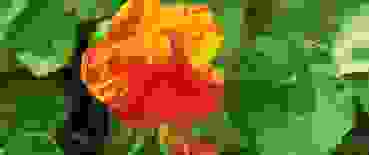
Nasturtium (Tropaeolum majus)
Nasturtium is a colourful addition to any garden – and its edible flowers also liven up all kinds of dishes. As a medicinal plant, it is used to treat bladder infections, inflammation of the sinuses and bronchitis.
The bright orange, red or yellow flowers of the nasturtium are used as an ornamental addition in gardens. Sometimes the flowers are even used to add a decorative touch to food. The nasturtium’s leaves and seeds are also edible. Yet this beautiful plant is even more versatile than you may think. It contains mustard seed oils, which have been proven to be effective against bacteria, viruses and fungal infections. Read on to find out more about the origins, appearance and healing properties of nasturtium.
Occurrence and distribution of nasturtium
All known species (around 90) of nasturtium originally came from Central and South America. They form their own genus: Nasturtium (Tropaeolum). The plant did not appear in Europe until the late 17th century. Today in Switzerland, it is often grown as an ornamental plant in country gardens and herb gardens. It is not only popular due to its appearance; it can also be eaten. Its flowers are used as edible decorations. Its tender, young leaves are used as a spicy, peppery addition to salads. The buds and unripe seeds can even be pickled and used like capers.
In German, they are called “Kapuzinerkresse”, and the word “kresse” is based on the old German word “cresso”, which means “spicy”. This refers to the slightly peppery, spicy flavour of the leaves and flowers that is caused by the mustard seed oils contained in the plant. The first part of the name – Kapuziner – refers to the shape of the flower. Viewed from the side, it looks similar to the hoods worn by the Order of Friars Minor Capuchin.
The most famous nasturtium is the Tropaeolum majus L., which is known as garden nasturtium, Indian cress, or monk’s cress. Today it is also commercially cultivated for its medicinal properties.
Appearance of nasturtium
Garden nasturtiums form tendrils that enable them to climb fences, trees, climbing aids and trellises. They grow up to three metres high. They feature striking, almost perfectly circular leaves that balance atop centralised stems. When it rains, the water droplets roll off the surface of the leaves. This is referred to as the lotus effect, as it is also a key characteristic of lotus plants. Nasturtiums usually bloom from June until October, until the first frost. The colour of the flowers ranges from yellow to orange and red. In Switzerland nasturtiums are annual, because they cannot survive the cold winters.
Active ingredients and effects of nasturtium
In the 18th century, nasturtiums gradually became more well known in Europe, where initially they were mostly used as ornamental plants. Their high vitamin C content meant they were soon also used to treat scurvy, a disease caused by vitamin C deficiency. They also contain essential oils and various plant substances that act as antioxidants, such as carotenoids.
Nowadays, we know that nasturtium’s most significant medicinal potential lies in its mustard seed oils. These substances are known as isothiocyanates and they help to prevent the proliferation of bacteria, viruses and fungi. There has been a rethinking of the treatment of infections today. In recognition of these and other benefits, the nasturtium was voted Medicinal Plant of the Year in 2013.
Nasturtium as a medicinal product
Given that nasturtiums have an inhibiting effect on bacteria, they can sometimes be used instead of antibiotics for the treatment of infections. Medicinally, the horseradish root is used, for example, in combination with nasturtium herb.
Combined preparations with horseradish
Garden nasturtiums (Tropaeolum majus L.) and horseradish (Armoracia rusticana G. Gaertn. et al.) complement each other particularly well. Both of them contain antimicrobial mustard oils. It is interesting that they not only have an effect against a specific pathogen but also against many others as well. As a combination, they are used to treat the following symptoms, for example:
- uncomplicated urinary tract infections (cystitis)
- acute infections of the bronchial tubes (bronchitis) and sinusitis.
This is general information. For individual advice, please contact a specialist.
Modern herbal medicine
Modern herbal medicine (phytotherapy) combines centuries-old knowledge with the latest scientific findings.
Details

